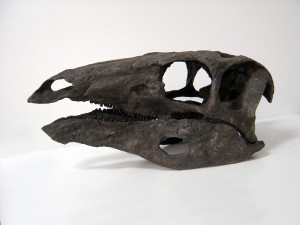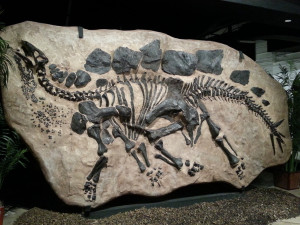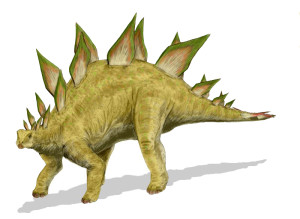Updated on: 04/04/2022
Stegosaurus is a genus of extinct, armored stegosaurid dinosaur that lived 155 – 150 million years ago. Remains of 80 individuals have been unearthed from the upper Morrison Formation in the western United States. It coexisted with large predatory dinosaurs, like Ceratosaurus and Allosaurus.
| Kingdom: | Animalia |
| Phylum: | Chordata |
| Clade: | Dinosauria |
| Order: | Ornithischia |
| Suborder: | Stegosauria |
| Family: | Stegosauridae |
| Subfamily: | Stegosaurinae |
| Genus: | Stegosaurus |
| Species: | S. armatus (type species) S. ungulatus S. stenops S. sulcatus |
| Name Meaning: | “roof lizard” or “plated lizard” |
| Pronunciation: | STEG-o-SAWR-us |
| Geological Time Period: | Kimmeridgian to early Tithonian, Late Jurassic era |
| Size: | Length – 26 to 30 feet Height – 9 to 10 feet |
| Weight: | 6800 to 7000 lbs |
| Range/Location: | North America and Europe |
| Diet: | Herbivore |
| Habitat/Environment: | Woods or plains |
| Closest relatives: | Kentrosaurus (East Africa) and Wuerhosaurus (China) |
| Speed: | 6–7 km/h maximum |
| Locomotion: | Quadruped |

Stegosaurus was a large, heavily built animal known for its unusual appearance. It had a long and narrow skull; and small, flat and triangular teeth. Their hindlimbs were longer than their forelimbs. All four limbs were backed up by pads behind their toes. It had three short toes on the hind feet, and they had five toes on the forefoot. It had two pairs of spikes horizontally ending near the end of their tail. Compared to its overall built, their brain size was similar to that of the size of a walnut. Their actual brain anatomy is not well known.

One of their distinct features was their seventeen flat highly modified kite-shaped osteoderms on their heavily rounded back. They were directly not joined to the skeleton, but it was stuck to the animal’s skin. The largest plates were around 60 cm wide and 60 cm tall. Some theories even suggested that the plates could have been mobile. There are several hypotheses regarding the usage of the plates, such as body temperature control, intimidating enemies or sexual display. Some researchers have blown off the sexual display theory as they did not have any sexual dimorphism
The genus name Stegosaurus came from Greek words “stégos” meaning ‘roof’ and “saûros” meaning ‘lizard.’
In 1877, Stegosaurus was first described by Othniel Charles Marsh from remains recovered north of Morrison, Colorado. At first, Marsh wrongly thought that they were of an aquatic turtle-like creature. The holotype was named Stegosaurus armatus (meaning ‘armored roof lizard’). A series of Stegosaurus bone remains were unearthed in the following few years. Marsh released several papers on this genus describing several species. But later some of those were termed as invalid or synonymous with other species. In 1879, Stegosaurus ungulates (meaning ‘hoofed roof lizard’) was named by Marsh from fossil samples unearthed at Como Bluff, Wyoming. It has been suggested that it could be synonymous with S. armatus. In 1887, Marsh described Stegosaurus sulcatus (meaning ‘furrowed roof lizard’). Earlier it has been considered as synonymous with S. armatus, but recent papers indicated they were distinct species. In the same year, Marsh described Stegosaurus stenops (meaning ‘narrow-faced roof lizard’). It is the best-known Stegosaurus species with at least fifty partial skeleton samples of both adults and juveniles. Stegosaurus stenops was shorter than Stegosaurus armatus. The remains found in Portugal made paleontologists believe that they were also present in Europe. The specimen has been assigned to Stegosaurus ungulates.

Its short neck and ‘head held low on the ground’ posture (probably not more than 3.3 feet) suggests that they were ground feeders. Stegosaurus was quadrupedal, but there were some theories that suggested that they could stand up on their hind legs using their tail forming a ‘tripod.’ Their track of footprints found by Matthew Mossbrucker suggests that they lived in herds consisting of adults and babies. There are several theories regarding the usage of spikes, such as defense and display among others. Some scientists have criticized the defense theory as they were ill-placed and too fragile.